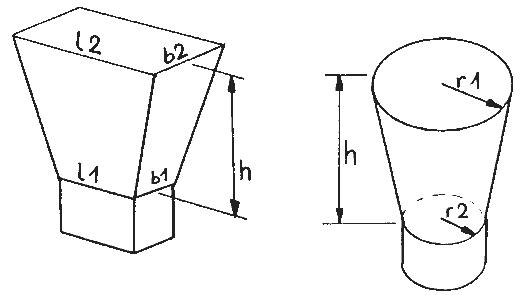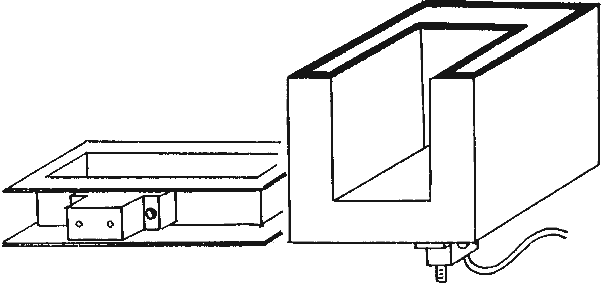4. selection of vibrators
4.1 Introduction
In this chapter, suggestions are made about vibrator selection for the appropriate use cases, keeping in mind that this cannot be done simply with the help of a table, graphs or fixed calculations. Each application has its own influencing variables. Very often the vibration propagation is affected by design characteristics, non-optimal stiffness or other things. Thus, the following illustrations can only be an aid to selection. The optimum design can only be found by approximation with the help of the air pressure setting where the natural natural frequency or the optimum frequency is found which leads to the best working results and by trials.
There are many applications where several vibrators are needed. In these cases the decision which vibrators to choose depends on cost and volume.
Basically, 7 factors should be taken into consideration:
- Air consumption
- Volume
- size / mounting surface
- Frequency required
- vibration amplitude / vibration energy
- costs / maintenance costs
- air supply / oiling possible/necessary
The following tables list different vibrators depending on their force and frequency. Other important factors are cost, volume and air consumption. For example, in some cases it makes sense to choose a Golden Turbine (GT) vibrator, which is much quieter and has less than half the air consumption of a ball vibrator, while in other cases where air consumption and/or noise are not important, the ball vibrator is much less expensive.
Procedure:
- Selection of all possible vibrator types and models that meet the force requirements.
- In case of requirement for quiet running, do without the noisy types.
- If oil-free operation is required, do not use types T-, DAR-, FP- (however, there are FPLF- without lubrication requirement).
- If low air consumption is required, do not use ball and roller vibrators (K-, R-, DAR-). Air consumption data are listed in chapter 10 (Technical data).
- Comparison of demand and supply of the assembly area.
- Cost estimation (one GT vibrator can do the work of two K vibrators, saving costs in the long run).
4.2 Hopper and hopper
4.2.1 Calculation
The most important parameter in the evaluation of the vibrator requirement is the weight of the material to be excited. As far as hoppers and funnels are concerned, only the weight of the material which is in the inclined area is of interest.
Weight of the material:
W(material) = volume × density of the material
W(Material) = (b1 × L1 + b2 × L2) / 2 × h × density for rectangular hoppers
W(material) = (r1 × p + r2 × p) / 2 × h × density for round containers

Calculation of material weight in bunkers and hoppers
4.2.2 Vibrator table
Often it is better to use two smaller vibrators placed opposite each other instead of placing one large vibrator in order to prevent the load from becoming too great at one point of the structure.
Material | ||||||
Weight of material in kg | dry/loose | wet/wet/sticky | ||||
ball | Rollers | Golden | (Ball) | Rollers DAR type | Golden | |
loud | loud | quiet | loud | loud | quiet | |
50 | K-8 | GT-8 | K-10 | GT-8 | ||
100 | K-8 | GT-8 | K-13 | GT-8 | ||
200 | K-10 | GT-8 | K-16 | GT-8 | ||
300 | K-13 | GT-8 | K-20 | GT-8 | ||
500 | K-16 | GT-8 | R-50 | GT-8 | ||
800 | K-20 | R-50 | GT-8 | R-50 | DAR-2 | GT-10 |
1,000 | K-25 | R-50 | GT-13 | R-50 | DAR-2 | GT-16 |
1,500 | K-30 | R-50 | GT-16 | R-65 | DAR-3 | GT-20 |
2,000 | K-36 | R-65 | GT-20 | R-80 | DAR-4 | GT-25 |
3,000 | K-36 | R-65 | GT-25 | R-100 | DAR-5 | GT-36 |
5,000 | R-80 | GT-30 | R-120 | DAR-6 | GT-40 | |
8,000 | R-100 | GT-40 | DAR-7 | GT-78 | ||
10,000 | R-100 | GT-48 | DAR-7 | GT-48-S | ||
Bunker and hopper selection table
4.3 Chutes and screens
To select the correct vibrator, the material weight and volume to be conveyed should be known. For smaller troughs and screens up to about 120kg, piston vibrators can be selected. For larger machines, rotating vibrators, especially turbine vibrators, are the better choice.
When choosing two vibrators, they should be mounted on the same rigid profile. The vibrators will then immediately synchronize and double their force.
4.3.1 Calculation
Total weight to be driven:
W(vib.) = weight of the trough or screen (vibrating part) + weight of the material on top.
4.3.2 Vibrator table
Total weight in kg | Ball- | Roller- | Roller- | Turbine- | Piston- |
5 | FP-12 | ||||
10 | FP-18 | ||||
15 | FP-18 | ||||
20 | K-8 | FP-25 | |||
30 | K-8 | FP-25 | |||
40 | K-10 | FP-25 | |||
50 | K-13 | FP-35 | |||
75 | K-16 | GT-10 | FP-35 | ||
100 | K-20 | GT-10 | 2xFP-35 | ||
150 | K-25 | R-50 | DAR-2 | GT-16 | |
200 | K-30 | R-50 | DAR-3 | GT-16 | |
300 | K-36 | R-65 | DAR-4 | GT-25 | |
400 | 2x K-36 | R-80 | DAR-5 | GT-36 | |
500 | R-100 | DAR-6 | GT-36-S | ||
750 | R-120 | DAR-7 | GT-48 | ||
1,000 | R-120 | DAR-7 | GT-48-S | ||
2,000 | 2xR-120 | 2xDAR-7 | 2xGT-48-S |
Selection table for troughs and sieves
1 FP piston vibrators are available as S(small), M(medium) and L(large) amplitude types and for oil-free operation as FPLF types.
SA = small amplitude | LF = low frequency |
MA = medium ampl. | MF = medium frequency |
HA = high ampl. | HF = high frequency |
4.4. formwork and molds for concrete and casting applications
The main influencing factors are the weight of the form and the nature of the material.
Note: The selection of the vibrator type from the table will always have to be tested in trials for its working result. Especially with concrete, the vibration time is crucial to be sure that the concrete is sufficiently compacted. The table can only be an aid for vibrator selection.
Conditions | |||
Weight of the filled mold | Wet | Wet | Dry |
20 | R-50 | R-50 | R-65 |
50 | R-50 | R-65 | R-65 |
100 | R-65 | R-65 | R-80 |
200 | R-65 | R-80 | R-100 |
500 | R-80 | R-100 | R-120 |
750 | R-120 | R-120 | 2x R-120 |
1'000 | 2x R-120 | 2x R-120 |
|
Selection table

Attachment of vibrators depending on the (casting) mold.
If more than 10cm of concrete is to be compacted, DAR vibrators (Fig. top right) are recommended. DAR vibrators produce a very large amplitude that penetrates deep into the concrete.
Shallow forms (like Fig. above left) should be excited with DAR vibrators if the total width is >20cm or >40cm when using 2 vibrators. For widths <20cm, R and GT series vibrators also give good results.
To achieve well compacted, bubble-free surfaces, GT vibrators should be activated for approx. 10 seconds. Due to its high frequency, GT vibrator achieves high compaction in the surface.
4.5 Molds
To select vibrators for separating sand from molds, use the "Dry" column of the above table. The use of GT vibrators is recommended because oil-free operation is possible and its bearings are sealed against contamination (sand dust) so that they cannot be damaged. The vibrator should be supplied with 0.5 bar air pressure even when not in use, or the air outlet should be led away from the dusty environment with an exhaust hose, so that no dust particles can enter the vibrator's air outlet during the filling process. Higher pressures are necessary for the vibrator to work.
 Deutsch
Deutsch English
English Nederlands
Nederlands

![[Translate to Englisch:]](/fileadmin/user_upload/Neue_Bilder_2022/Headerbilder/Header.jpg)